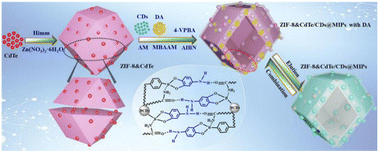Hollow structure molecularly imprinted ratiometric fluorescence sensor for the selective and sensitive detection of dopamine†
Abstract
Developing hollow-structure quantum dot carriers to increase quantum luminous efficiency is a creative idea for designing a novel sensor. A ratiometric hollow CdTe@H-ZIF-8/CDs@MIPs sensor was developed for the sensitive and selective detection of dopamine (DA). CdTe QDs and CDs were used as the reference signal and recognition signal, respectively, and thus showed a visual effect. MIPs provided high selectivity toward DA. The TEM image demonstrated that the sensor was a hollow structure, which could have ample opportunity to excite quantum dots to emit light through multiple light scattering through holes. In the presence of DA, the fluorescence intensity of the optimum CdTe@H-ZIF-8/CDs@MIPs was remarkably quenched by DA, achieving a linear range of 0–600 nM and a limit of detection of 12.35 nM. The developed ratiometric fluorescence sensor showed an obvious and meaningful color change with a gradual increase in DA concentration under a UV lamp. Moreover, the optimum CdTe@H-ZIF-8/CDs@MIPs was remarkably sensitive and selective in detecting DA among various analogs and showed good anti-interference ability. The HPLC method also further confirmed that CdTe@H-ZIF-8/CDs@MIPs shows good practical application prospects.



 Please wait while we load your content...
Please wait while we load your content...